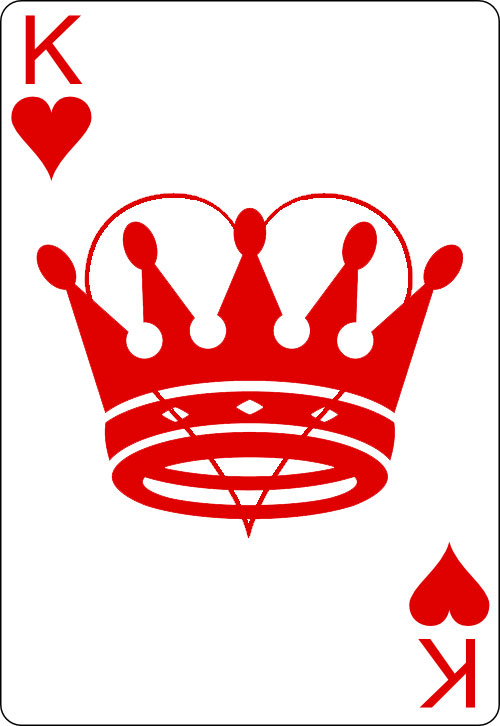
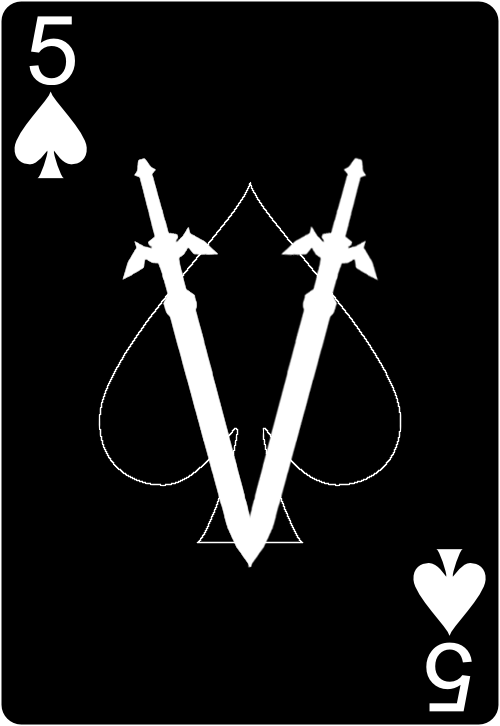
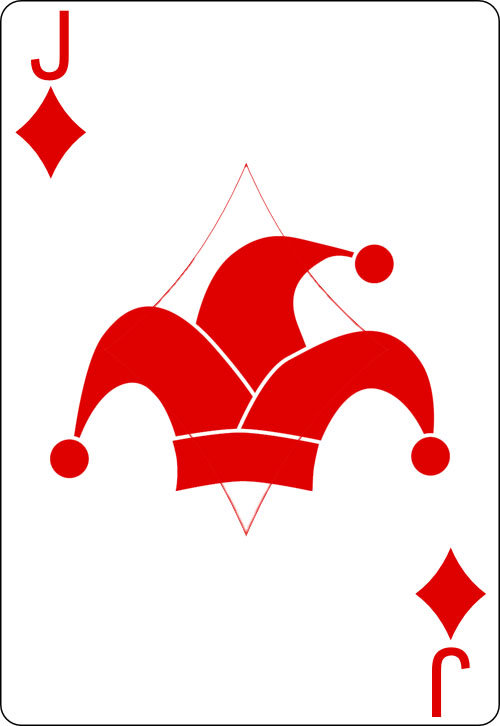
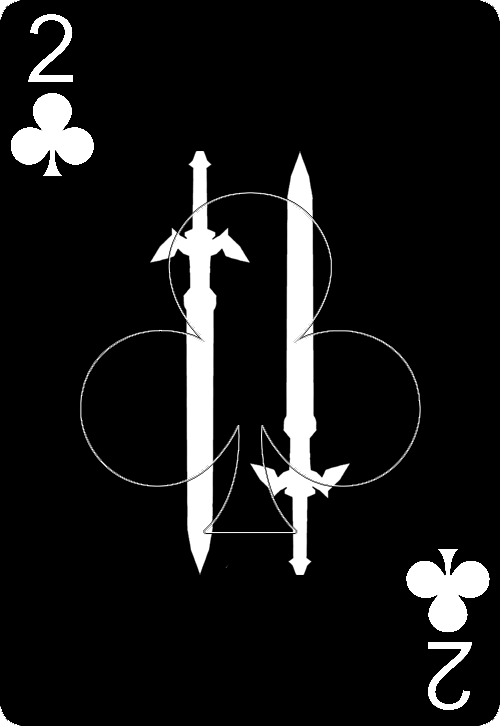




Sample set of card design. Note the distinct colors between black and red to emphasize the additional rule of color to the standard poker hierarchy. Additionally, the designs help demonstrate the theme centered around combat.
Original card images courtesy of Google Code's vector-playing-cards; sword art taken from Legend of Zelda's Master Sword; design by Stephen Yin.
As an avid spectator/occasional player of poker, I wanted to modify the game of poker to amplify the importance of reading other people's cards and bluffing. The idea that I settled upon was to create a game where all cards are initially hidden from everyone's view, but as the game continues for longer and longer, a careful player will be able to begin to deduce what other people have through a few means: tracking swaps with the pot which are visible to everyone, reading reactions to the pot (choosing to swap or not), and dealing with the ability to bluff with double downs. With these additional elements emphasized from its parent game, Five Card Poker Clash would hopefully be an exciting twist on the well-known game of poker.
The deck used for this game was a standard deck of 52 cards with 4 suits and 13 values. Since this game was created to be a game of clash between players, a theme of combat was chosen for the cards. To create the cards, I took a standard set of poker card images from Google Code and took a few images to photoshop to sample how the deck would look. The main modifications made included changing the background to black for spades and clubs (to emphasize the new rule of color in the poker hierarchy), using roman numerals formed from an image of a sword (to showcase the theme of combat), and making all cards dichromatic (to demonstrate the idea that the outcome of war is two-sided: triumph or perish).
As a final note, the cards were designed to maintain a minimalist aesthetic because I personally find minimalism in design to be quite pleasing.
In the first version of Five Card Poker Clash (v1.0), the general idea and rules were largely the same as the final version with the main difference being that betting was embedded with the gameplay. v1.0 involved betting in order to be able to draw a card, but this quickly became a problem as the first person to bet had an unfairly large advantage, getting to view a card and have the chance to immediately initiate a clash. In v1.1, this problem was amended by implementing separate betting and drawing rounds.
v1.1 introduced a new host of problems as the rules for betting and drawing were still being fleshed out. Namely, players were allowed to initiate a clash any time during the round of betting. This problem became apparent as the player with the desire to initiate a clash could be a large amount, wait until their opponent bet, and then declare a clash. So, while their opponent believed they had an opportunity to draw another card, a post-bet clash could unfairly take advantage of that fact. v1.2 limited the ability to initiate a clash only during the initiator's turn to bet.
In v1.2, most elements of the game were relatively balanced with no glaringly obvious imbalances. During gameplay, it was noted that the player who drew first had a slight disadvantage as the following player could choose to take the card in the pot or draw a new one, giving two options to create a better hand. However, this was theorized to balance itself out since the opponent would know what card was taken if the player swapped the pot, and who drew first would alternate every round. Additionally, whenever a player chose to raise the bet, they would become the first player to draw the next round of drawing, adding an implicit punishment for raising (and theoretically forcing players out or value-betting on their hand). To add a new element to the clash round, v2.0 introduced a highly risky concept of doubling down.
v2.0 was the final version with doubling down. After initiating a clash, the initiator was given the opportunity to double down by revealing their choice of three cards from their hand in exchange for the benefit of others limited to only calling at twice the initiator's bet or folding (eliminating the opportunity for others to raise the bet). This added an exciting element of risk into the game while adding a new dimension of fooling other people. In one of the playtesting rounds, one player doubled down and revealed three cards from a broken straight, prompting their opponent to fold when in reality the straight was not complete.
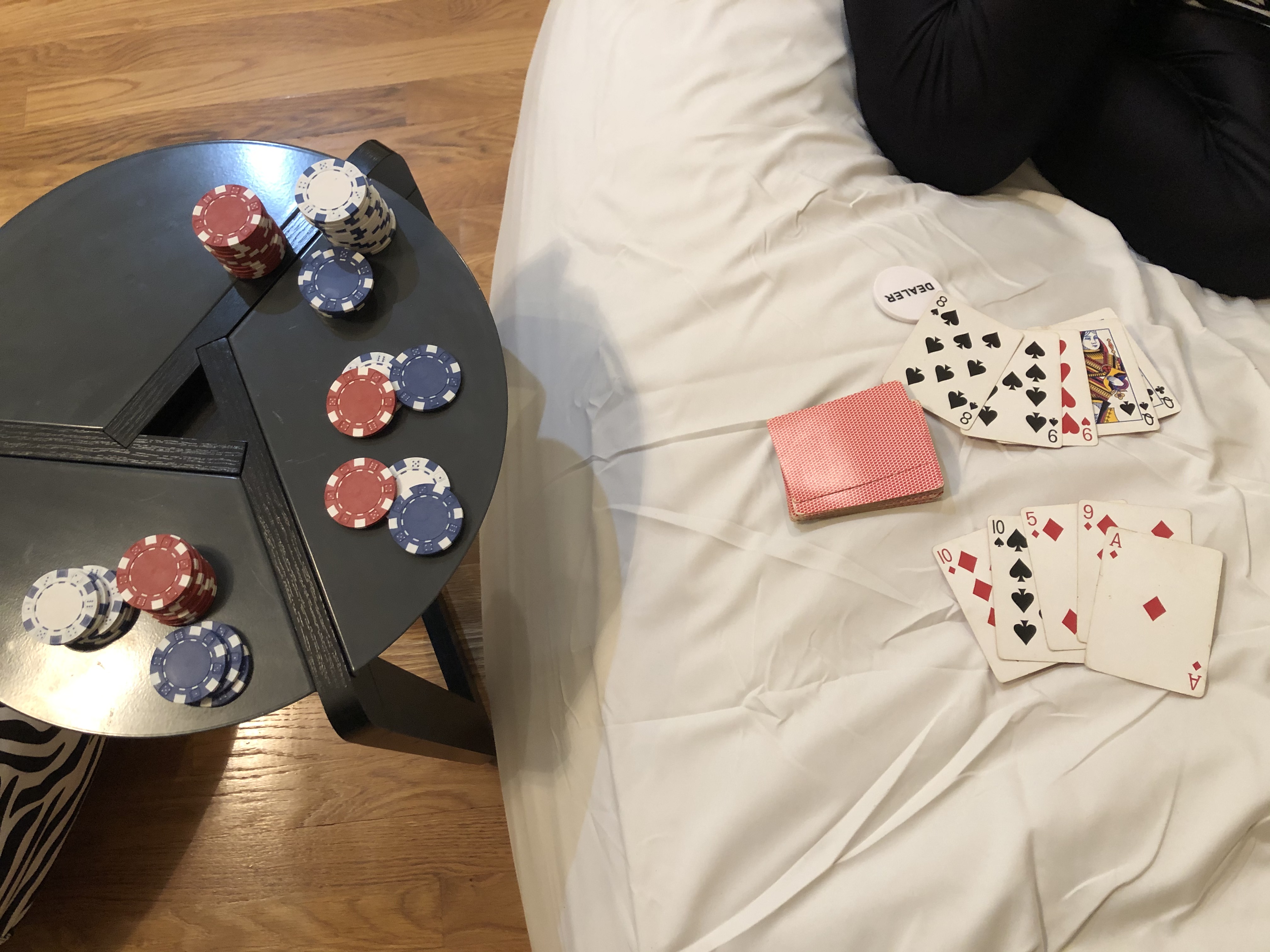
Aftermath of a clash round. The dealer and player both bet one chip each of red (5), blue (10), and white (1). The dealer wins with a two pair beating out a one pair.
Overall, I thought the new game was an enjoyable twist to poker. In later research, I found out that a 5 card draw variant of poker already existed, but my version introduced enough unique play including the pot and doubling down that I argue Five Card Poker Clash can be classified as its own unique game. Although playtesting was only done in reality with two people (limited by the number of people in my household currently), a lot of playtesting was done by running through theoretical situations imaginatively as well. In particular, the idea of the pot gave a clear advantage to the person immediately after the first person to draw, but I imagine the pot would soon quickly lose its value was more cards were placed in it. It would be interesting to see how much the pot would be utilized depending on the number of cards it holds. On another note, I was especially pleased with the concept of doubling down as it added a whole new dimension of psychological play, allowing players the opportunity to confidently bluff their way out of tricky situations. Doubling down turned out to be a useful tool to win big when used effectively in the right scenario. The additional rule of colors in the poker hand hierarchy was placed in accordance to the mathematical chance such a hand could be obtained. As it turns out, a monochromatic hand occurs with a frequency of 2*(26 choose 5) = 131,560 which would place it at just higher than a two pair (frequency: 123,552) and much lower than a one pair hand (1,098,240). The game still has many quirks to be balanced, but as it stands, Five Card Poker Clash has been an enjoyable game to play and work on.
5 Card Poker Hands (Highest to Lowest)
Royal flush
A, K, Q, J, 10, all the same suit.
Straight flush
Five cards in a sequence, all in the same suit.
Four of a kind
All four cards of the same rank.
Full house
Three of a kind with a pair.
Flush
Any five cards of the same suit, but not in a sequence.
Straight
Five cards in a sequence, but not of the same suit.
Three of a kind
Three cards of the same rank.
Two Pair
Two different pairs.
Color
Five cards of the same color (black: spades, clubs; red: diamonds, hearts)
Pair
Two cards of the same rank.
High Card
When you haven't made any of the hands above, the highest card wins.